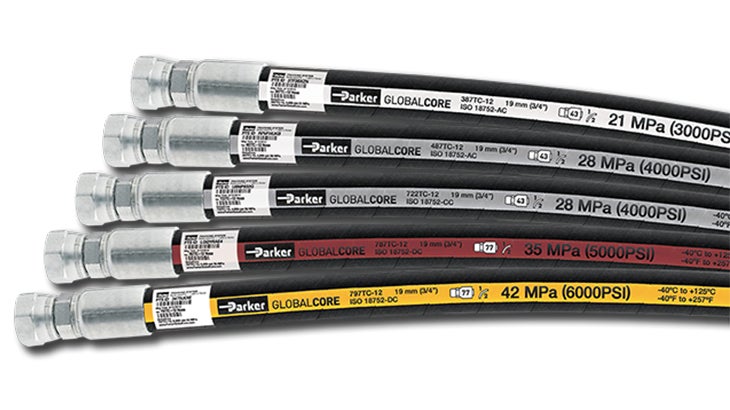How to Select the Right Hydraulic Hose

Does choosing the right hydraulic hose for your application have you overwhelmed and confused? It’s easy to understand why. Improper selection can lead to hose failures which may result in downtime, damage, unwanted clean up and personal injury. So, how do you determine the right hose for your application?
Ask yourself these questions:
What’s going through the hose?
Not all hoses are manufactured to convey all media. Even if it’s just hydraulic oil, it’s important to know which type of hydraulic oil. Various core tube types are available for compatibility with these different oils/medias.
What flow rates do I need and what’s the working pressure of my system?
Knowing the flow rates needed will help you determine the inside diameter of your hose. All hydraulic hoses are measured by the ID and are identified in 16th’s of an inch. For example, a ¼ ID hose is considered a -4, a ¾ ID hose is a -12, and so on. You must also know the working pressure of your system.
Does my machine need to meet any industry specifications?
Does your machine need to meet European standards (EN), International Standards Organization (ISO) requirements, or Society of Automotive Engineering (SAE) guide lines?
What are my operating temperatures?
You must know the minimum and maximum temperatures of your media. Just as all core tubes are not compatible with all medias, they are also not built to withstand all temperatures.
Do I need a more robust hose cover?
Many hoses today are available with abrasion resistant covers. If abrasion could come into play in your application, you may want to consider this. There are also various types/forms of external abrasion covers that can be added to your hose assembly. This can bring additional life to your hose assemblies. Remember, hoses rubbing on other hoses abrade more rapidly than hoses rubbing on a fixed object, such as a machine frame.
Once you’ve answered those questions, choosing the right hose should be simple. That said, here’s a few common mistakes to avoid when selecting your hose.
Buying on price alone
One of the most common mistakes we see is when buyers only consider the price when selecting their hose. Hose pricing can vary dramatically based on the features and application criteria. A standard product may be the least expensive option, but what if a premium hose added 2 or even 5 times the life?
Underestimating abrasion
One of the most common causes of hose failure is abrasion. Be sure to understand your application and if your hoses will be exposed to abrasion. Consider good quality, “tough” or “super tough” covers on your hoses. Sleeves, pads, and spring guards are also good options to protect your hose.
Mixing/matching hoses & fittings
Manufacturer A’s fitting needs to be assembled on Manufacturers A’s hose. When you’re in a pinch and want to get back up and running, it sometimes seems simple to grab any hose and any fitting. But you need to remember that a hose assembly is an engineered system – the fitting must be made to work with the hose. Mixing and matching can result in failure, and will not be warranted by the manufacturer. You also do not want to crimp a new fitting on a failed hose that has been in service. The dimensions of a used hose have changed due to pressurization, and will not allow the new fitting to be assembled properly.
Selecting the right hose can be challenging, but knowing your needs can help get you the right product for your application. By selecting the proper hose from the start, suppliers can help their customers lower their cost of ownership. Avoiding downtime, clean up, and maintenance can help to improve your bottom line while maximizing uptime.
Post contributed by: Scott Schoepf, VP of Sales & Marketing, Triad Technologies